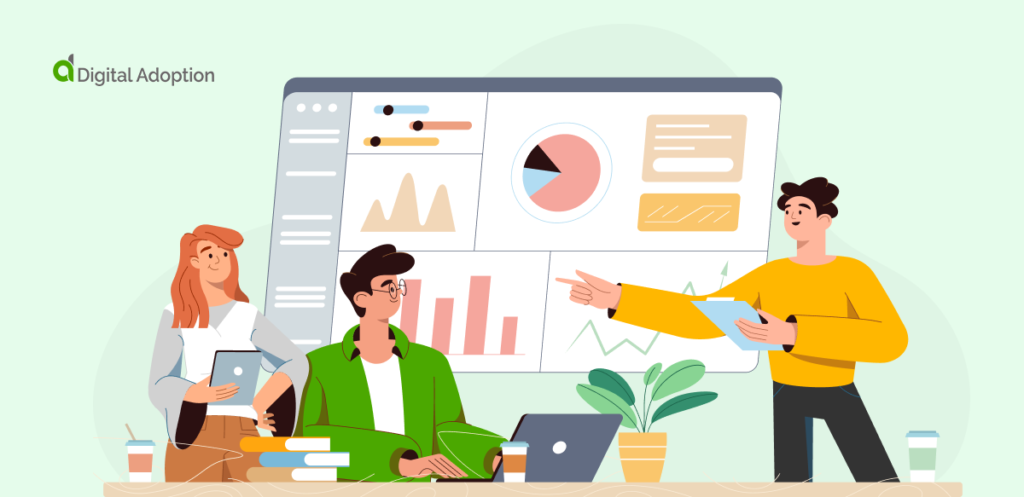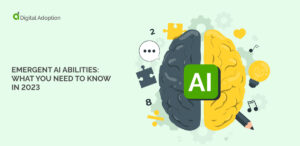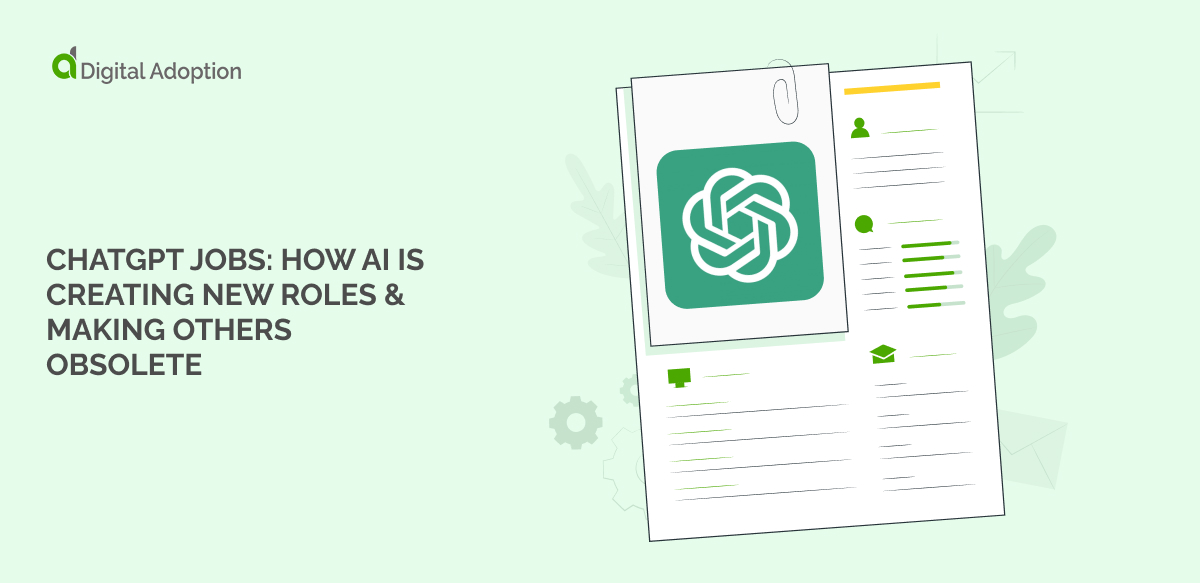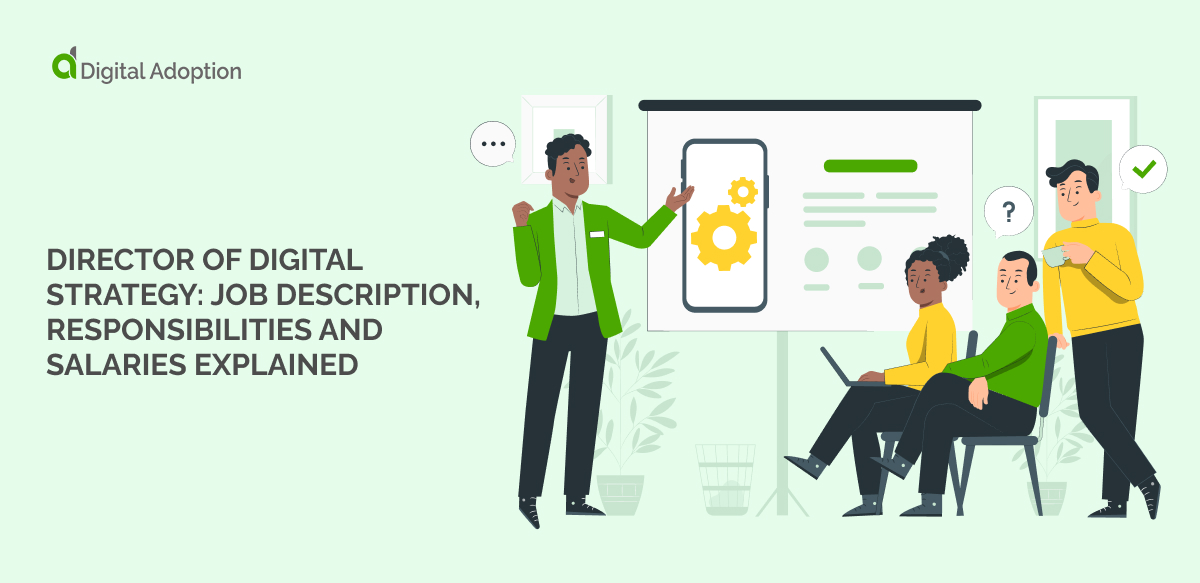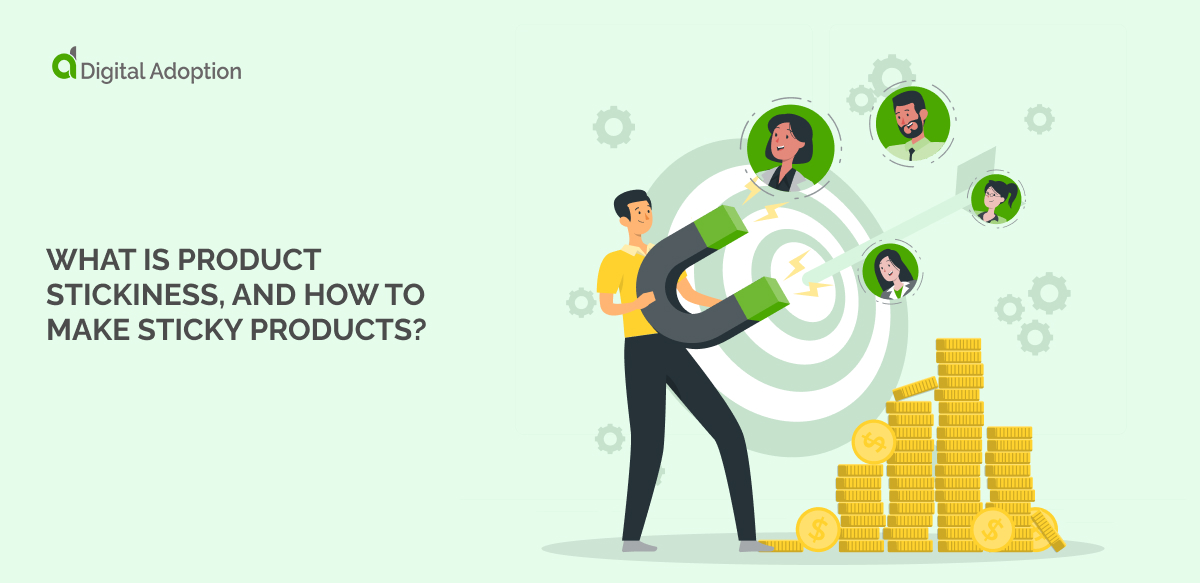Is your digital adoption strategy failing to meet your business goals? Our comprehensive guide to improving digital adoption will get your strategy back on track.
Effective on-demand training and harnessing the data generated to provide more personalized training are keys to successful digital adoption. It comes down to a digital adoption platform and analytics reports.
As organizations add better digital adoption solutions to their stack of tools, achieving digital adoption becomes harder. But when we understand how to make training less daunting, we can motivate users to train themselves.
With the digital revolution upon us, developing a digital-friendly business has never been more critical. Many organizations shy away from new software solutions because they fear change. Those staying ahead of the curve understand the need to adapt to evolving demands.
The only way to accomplish positive growth in the digital age is to embrace the limitless potential of new technology. To achieve this success, business leaders are turning to digital adoption. Even the most ambitious leaders realize the challenges of such drastic change.
Some of the obstacles businesses face are employee resistance, lack of adequate IT skills, and a poor implementation plan. You need to boost your digital adoption strategy to see positive returns on your technology investments.
Consider this article your go-to stop for improving digital adoption. We’ll discuss the benefits of successful digital adoption and why it’s essential to your company’s growth. We also explore helpful tips to boost your digital adoption efforts.
Keep reading to learn the strategies leading organizations use to drive digital adoption.
What Is Digital Adoption?
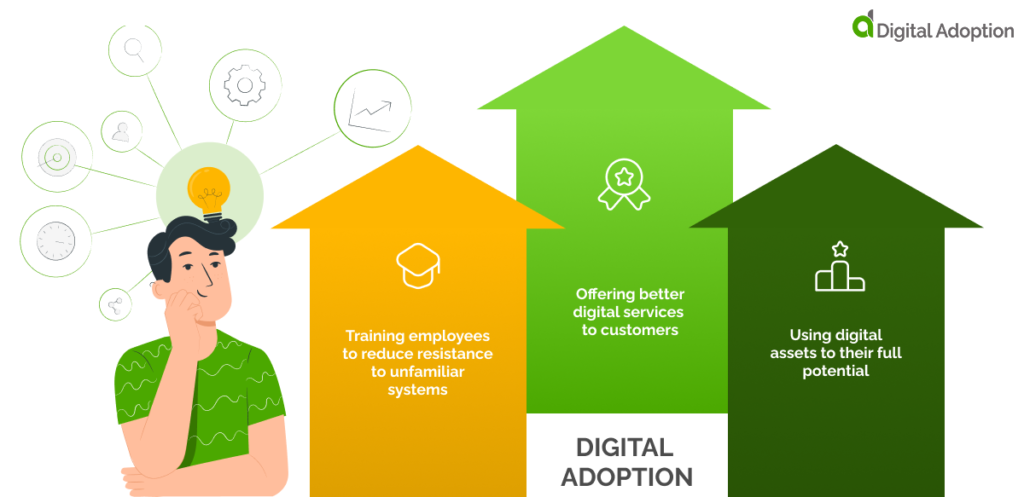
Digital adoption is a state where a technology implementation achieves its full business value. It means that your employees are on board the new software solution and taking full advantage of its capabilities. It mostly revolves around training effectiveness and change management.
Before improving your digital adoption strategy, let’s establish what we mean by digital adoption.
Every company uses digital technology to improve customer service and complex business processes. Digital adoption is about getting the most out of a new software solution to see a positive return on investment (ROI).
For example, your favorite coffee shop might release a new app, allowing customers to order from home. But is the app as good as it could be? Can customers pay through the app or browse the menu in advance? Digital adoption targets areas for improvement and helps a company.
Digital adoption means using digital assets to their full potential. There are several steps to this process involving every level of an organization. Digital adoption strategies aim to increase companies’ engagement with new digital technologies.
This means training employees to reduce resistance to unfamiliar systems. It also means offering better digital services to customers. High user engagement indicates that a business is getting the most out of its technology investments. Businesses fail to boost user engagement because they don’t know how to improve training effectiveness.
Why Is Digital Adoption Important?

Digital adoption increases productivity when using new technology. It ensures a business gets full value from the tech when end-users use it efficiently. That’s because it helps them understand and use the full potential of the technology. So they can work quickly and at their pace.
Gartner’s research suggests that ‘almost 50% of employees will continue to work remotely post COVID-19’ It’s easy to see why employees prefer working from home. The chance to communicate remotely and feel connected to your work is too good to give up. No one wants to go back to commuting five days a week.
The pandemic has created new opportunities for work across the world. But, before COVID-19, no one could have predicted such a drastic change. And who knows what the future of work will look like?
Digital adoption isn’t about seeing the future through a crystal ball. It’s about flexibility. Companies that embrace change by preparing for the unexpected. They are ready to adapt at a moment’s notice. Change like this is only possible by taking advantage of digital technology.
Remote work would be impossible without the development of video conferencing software. Organizations that valued digital adoption were the first to adopt this new way of working.
Digital adoption isn’t about having the best technology. It’s about knowing how to use the technology you have.
Mckinsey’s research found that 84% of employees don’t believe digital transformations improve their performance.
So how do you keep your teams’ attention long enough to use a technology implementation to the fullest?
Philip Grosch, PWC’s Digital Services Consulting leader, says, “No digital transformation initiative will be successful without a digital adoption strategy – and the right digital adoption platform to go with it.”
What Are The Benefits of Digital Adoption?

Digital adoption looks different for every business, depending on their goals. These are some of the benefits that every company experiences.
1. Increased productivity
Digital technology aims to simplify processes in the workplace. If done correctly, all areas of a business become more efficient. Employees experience a boost in productivity. Daily tasks become streamlined and more rewarding. Business processes also become automated, meaning users can focus on more important tasks.
2. Improved data analysis
Data is the driving force of organizational growth. Companies that focus on digitalization can collect and analyze more data efficiently. Digital solutions create actionable insights that impact key decisions for improving the business.
Most importantly, companies can collect more data on the behaviors and needs of their customers. Improved customer insights lead to a better customer experience.
3. A digital-first culture
Digital adoption encourages a digital-friendly organization. Companies achieve this by prioritizing the experience of users.
Successful technology integration involves tailoring digital tools to the needs of employees. After completing personalized training, employees begin to see the benefits of their new software program.
A lack of engagement leads to a poor digital adoption process. Once stakeholders and key decision-makers are on board, a business can scale up.
How To Improve Digital Adoption

Digital adoption has the potential to skyrocket your company to new heights.
Not only is digital adoption beneficial, but it’s also necessary for tackling disruptions. Digital tools are more useful than ever as we encounter future challenges. Gartner says that ‘the pandemic has only increased the urgency for digitalization.
But what if your digital adoption strategy is failing? If you don’t see the desired effects of digital transformation, you need to address your strategy’s weak points. Here are some actionable steps to improve digital adoption.
Seek Adequate Leadership Support
Change management determines the success of any digital adoption plan. Change management is the process of supporting employees during complex transformations.
Depending on the company, digital adoption strategies cause massive structural change. To avoid frustrated employees, make sure to support them throughout the process. This means contextual and personalized training for employees using new systems.
Incentivize Change and Reward Improvement
Business leaders understand the importance of motivating their employees. During the adoption process, employees can feel reluctant to learn new working methods. It’s crucial to incentive transformation.
The first step is to track user progress. Then you can identify the areas employees engage with and areas that need addressing. It’s up to senior management how to best reward their teams, but the best way to ensure user engagement is to reward learning.
Provide Solutions That Minimize Resistance To Change
User resistance is one of the biggest obstacles to digital transformation initiatives. Even the best software solution is useless if employees don’t engage with it. Before investing in costly technology, you should address issues within the company culture.
Ask yourself, why are my employees reluctant to learn new processes? Do they understand the benefits of new software? The solution is communication and education. Employees should feel energized by the prospect of transformation. Remind them that they are a key part of the digital adoption solution.
Adopt a Holistic Approach
Organizations make the mistake of transforming individual business areas during digital transformation. This targeted approach ends up being much more complex and expensive in the long run.
Digital adoption strategies need a holistic approach. This means implementing a company-wide implementation strategy. If you don’t transform all areas, you risk stalling the process altogether. A holistic approach also makes it easier to track digital adoption progress.
Improve Information Retention With Smart Onboarding
Learning to use new technologies can be daunting. Every employee absorbs information at a different rate. But there are ways to increase retention through proper training.
The best way to do this is by using a digital adoption platform (DAP). By integrating with new software, a digital adoption platform guides employees through the learning process. Digital adoption tools like these help navigate users through key tasks. They also provide vital insights so leaders can make necessary adjustments to the process.
A DAP provides an intelligent digital solution to user onboarding. They help to reduce employee resistance and improve information retention. Higher engagement helps ensure digital adoption is a success.
Enterprise Digital Adoption Improvement Use Cases

When improving your digital adoption strategy, it helps to have some role models. Here are two examples of large enterprises that have improved their digital adoption.
Domino’s Pizza

The fast-food giant harnessed the growth potential of digital technology to transform its business model. As Senior Vice President and Chief Digital Officer Dennis Maloney says, they’ve managed to evolve into an ‘e-commerce company that sells pizza.’ This speaks to the level of change the company has experienced.
In 2008, Domino’s stock fell, causing the company to launch an all-inclusive digital initiative to get back on track. The Domino’s Tracker became their most recognizable digital asset for customers. The next-gen delivery tool helped customers track their deliveries.
Experts agree that Domino’s leveraged digital technology to improve the customer experience. But how did they achieve this digital transformation?
Firstly, they recognized the importance of change management. The IT department had ongoing support from executives to install new tools. They also collaborated with marketing teams to get it off the ground. Creating a digital-first infrastructure propelled the company to new heights. Since 2008, its stock shares have seen an increase of 2,152%.
Tesla

Many people know that Tesla dominates the electric car market. Few realize how much digital transformation has played a part. The automotive company aims to create a sustainable, electric future. Digital technology has helped them move one step closer to this goal.
Tesla has created an alternative to the traditional driving experience by integrating digital technology in their vehicles. Their cars can even receive remote software updates to improve navigation and operation.
Tesla vehicles seem like an obvious place for digitalization to occur, but the company also changed its business model through digital transformation. Its direct-to-customer model cuts out the middleman and sells directly through its website.
Tesla produces their vehicles in-house, making the process more cost-effective and giving them space to innovate. Digital technology has changed how they build cars and transformed the customer experience. These innovations paid off. Tesla sits at an $830 million valuation.
How Does Digital Adoption Enhance Digital Transformation?
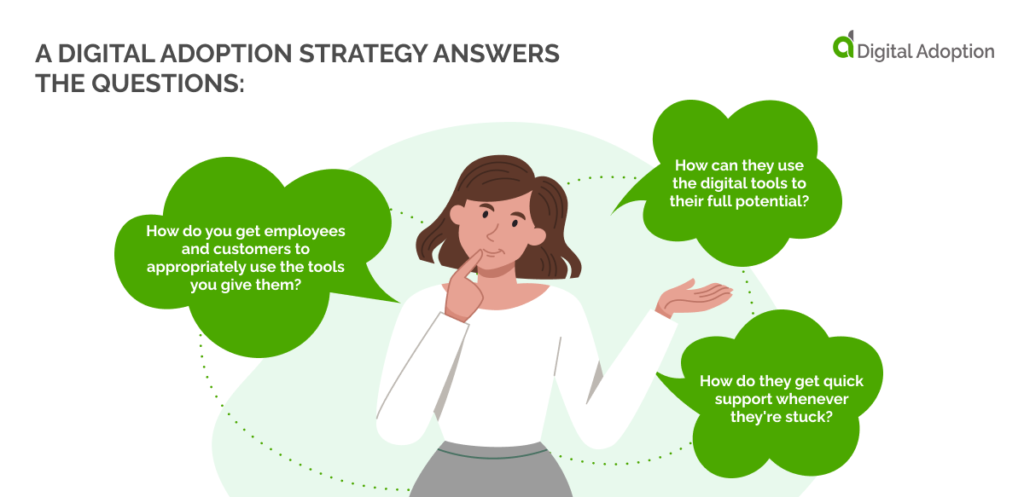
A digital adoption strategy answers the questions:
- How do you get employees and customers to appropriately use the tools you give them?
- How can they use the digital tools to their full potential?
- How do they get quick support whenever they’re stuck?
Digital adoption efforts enhance transformation by increasing training effectiveness. For example, when a company uses a digital adoption platform to provide on-screen guidance exactly when a user needs it. Since most users are not struggling to complete tasks, they can use their time for more valuable strategy activities and exploring the software.
Digital adoption enhances digital transformation by:
- increasing productivity because it removes unnecessary clicks
- increasing a transformation’s ROI because it trains the users to make the most of the platform
- reduces training while increasing its quality because employees get on-demand automated guidance
Let’s dive into the top 4 strategies to boost your digital adoption.
4 Key Digital Adoption Strategies That Enhance Overall Technology Adoption
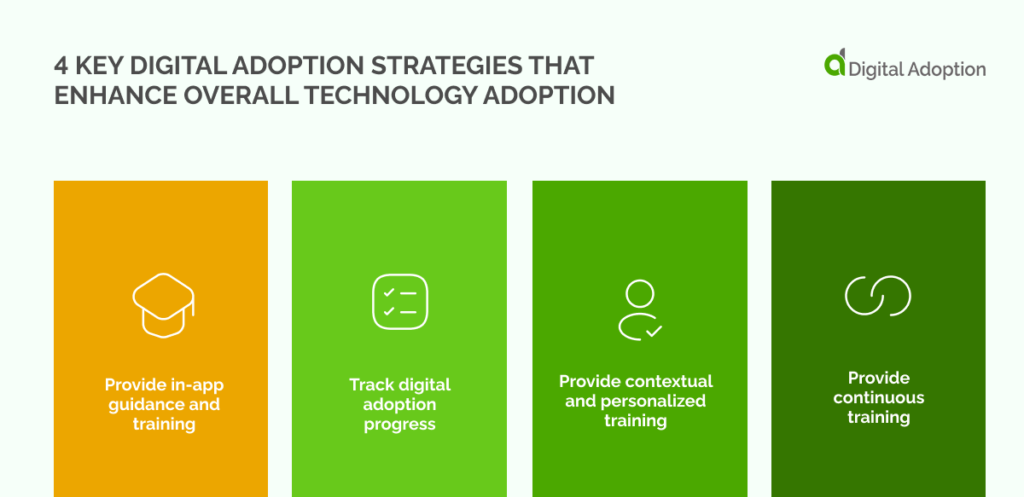
The best digital adoption strategies are to:
- provide in-app guidance and training
- track digital adoption progress
- provide contextual and personalized training
- provide continuous training
Diving deeper.
1. Use DAPs To Provide In-app Guidance & Training
A digital adoption platform (DAP) is an assistant that gives your staff real-time support when using a new app. It’s a fully automated and AI-driven software that lies ‘invisibly’ on top of a web-based or app-based platform to guide the user through tasks.
Or, in Forrester’s civilized definition DAPs are “low-code and no-code software platforms that leverage user and behavioral analytics and automation to deliver contextual nudges and personalized guidance that improve the usage, adoption, and experience of enterprise applications.”
Whichever definition, PWC used a DAP (Walkme) to get over 100k live users on Salesforce Lightning (a cloud-based CRM). So knowing that the CRM has too many functionalities for a beginner to keep up let alone use the potent features, they used Walkme to:
- Deliver Salesforce training inside the platform whenever an employee needs it (using pop-ups and Walkthroughs for step-by-step guides). The video below shows a Walkthrough demo on Zoho Training.
https://youtu.be/3rXUfp7DoLY (the power of walkthroughs) - Segment the training content to deliver relevant and hyperspecific information for different roles.
- Collect data on how the employees were using Salesforce Lightning. After identifying the pain points, they created resources to fill the gaps.
- Automate repetitive tasks, which also reduced help tickets
A DAP was PWCs digital adoption strategy. The staff could learn at their pace and in real-time forever. That is proper training. PWC liked the results so much that they used Walkme to roll out Workday (a human capital management platform).
Such benefits are equally invaluable in customer-facing software products. For example, after implementing a DAP, IBM achieved 4x better conversion rates and 6x higher engagement with their products.
IBM’s Chief Digital Officer, Nilanjan Adhya, and his team noticed they were losing customers in the early stages of using their digital products. So they used Walkme to create step-by-step on-screen guidance for core features, among other resources. They then integrated Walkme with Segment (a customer data platform) to collect data across all digital platforms in one place. The integration revealed the important milestones in the user journey and that the DAP increased the likelihood of a user achieving a milestone by 300%. They were so keen on gathering feedback that they integrated surveys into the experience.
Every digital interaction generates data. It’s a shame if a business won’t use this data to make informed decisions. It brings us to the next successful digital adoption strategy.
2. Track Progress & Draw Conclusions
Forty-three percent of business leaders concur that an analytics strategy drives digital transformation. With data, we can see where users drop off in a system’s user journeys. Once we identify the exact pain points, we can solve each with pop-up messages within the system. But most companies hardly see how users engage with their system unless they have an analytics strategy.
In 2019, Nestle struggled to get HR business partners and line managers to use their HR platform SuccessFactors® to its fullest potential. They pinpointed which areas the people were struggling in, then built a user-friendly DAP to provide in-app training and track progress.
The DAP’s analytics reports showed 15 critical user journeys that they re-engineered to reflect what the users were looking for and needed. They also included surveys at the end of each user journey, revealing better ways to optimize the employee experience.
The result?
Nestle met their digital adoption objectives within six weeks! Happier users, increased adoption of new features, and almost double task completion rates.
3. Provide Contextualized Training To Each User
Contextualized training delivers training content when the learner needs it in a real-world setting. Instead of expecting users to remember procedures from a webinar when using the software, you offer on-demand support. That means offering guidance only when a user needs it. E.g., a popup prompts a Salesforce user right when they get stuck.
In 2021, researchers tested how high school seniors perform when given contextualized teaching about statistics. They observed that the students came out of the study with a positive attitude and understood better than in instructor-led classes.
Sprinklr (a Customer Experience Management platform) employed such on-demand training to improve their employee and customer experiences. Despite their comprehensive virtual and physical training investments, employee surveys proved that Sprinklr needed to level up its employee onboarding strategy. So the team layered a DAP over their enterprise applications to provide in-app guidance as the users engaged with the applications. And they analyzed how users engaged with in-app training.
With contextual training, Sprinklr enjoyed a 20% reduction in support tickets and a 20% increase in training compliance. On the customer satisfaction front, Sprinklr had 85% less support burden and a 20% increase in documents’ open rate by prospects.
4. Set A Continuous Training Strategy
Continuous training is ongoing training where businesses give employees the tools they need to expand their knowledge and skill. In digital transformation, it translates to empowering employees with the resources to understand a technology adoption.
A Pew research found that 63% of working Americans consider themselves professional learners – they naturally keep learning to improve their skills. So failing to have the training resources available throughout is a major disservice to these folks.
A disservice that Nomisma (a cloud accounting suite) owned by adopting a self-help solution. Their self-help solution consisted of automatic notifications whenever Nomisma rolled out new features. These notifications triggered in-app step-by-step guides showing the customer the new capabilities.
Within five months, support tickets went down by 50%, and their client base grew by 314%. And according to the Director & Product Owner, Ash Hall, “the biggest point is the fact that we were able to scale so quickly without hiring new staff in a short space of time.”
Now let’s go over four digital adoption challenges and what to do about them.
Digital Adoption Challenges
Inadequate training is the main challenge with digital adoption. Other challenges include:
- complex software solutions,
- poor communication,
- and roles & process changes
1. Complex New Software
Back in 2018, the average company used 129 apps per customer. But after the pandemic, these numbers have soared to over 288 apps in an average enterprise. Naturally, employees switching between over 200 apps are unmotivated to use complex software. The approach to complex software solutions is two-pronged.
One has to do with changing the mindset. Colliers International’s IT Director, Mihai Strusievici, recommends that business leaders view digital transformation as a collection of small pieces instead of a monster system. In that mindset, they can break down digital adoption goals into individual activities they manage in small sprints.
And the other side is to implement a digital adoption solution that provides real-time in-app guidance and support whenever a user is stuck.
2. Lack Of (or Inadequate) Training
Consider that 86% of millennials would stick to their jobs if the employer offered relevant training and development. So if employees have relevant and ongoing training, they’ll likely stick to the digital adoption long enough to reap its full benefits.
We’ve already covered training in our digital adoption strategies above. So we won’t dwell here. But here’s an employee training playbook with more details.
3. Poor Communication
In 2001, HP’s Strategy Director, John Wargin, and Dirk Dobiey identified that employees reject digital transformations because they can’t see the big picture – how the tool will improve business. Things haven’t changed much almost two decades later. Gartner found that involving employees in creating and implementing their change strategy could boost adoption success by 22% and employee engagement by 38%.
The key takeaway here is transparency. Open two-way communication channels with all the affected users from the get-go.
4. Role & Process Change
It’s already tough enough for employees to learn new technologies, but when does digital adoption interfere with the status quo? Imagine that you want to introduce a better CRM to your sales department. But on further examination, the CRM system cannot integrate with other enterprise applications that it’ll communicate with. So besides using a new CRM, your team has to learn the new business processes you’ll introduce when you change other systems. And worse, these changes cut across departments. The same applies when your organizational structure changes.
We recommend that business leaders approach digital transformation initiatives from the business strategy context. Instead of forcing business processes into the latest technology, the technology should fit into the organization.
Nonetheless, a company can only invest in better training with digital adoption off the ground. That could mean adding a DAP layer to provide in-app guidance in the new system.
Digital Tools Make Everything Run Smoothly

The main pillars in a digital adoption plan are training and the data generated from the training. Top businesses invest in real-time training and track user progress to provide relevant training. The power is in the data.
With effective training, your team overcomes one of these digital transformation challenges.
Are you ready to improve your digital adoption?
Now you can begin to rethink your strategy, implementing the tips we’ve outlined above. If you need a helping hand, we recommend using digital tools to boost your adoption efforts.
Digital adoption platforms are the best way to ensure digital adoption success. Integrating new technologies is a complex operation. Not only do you have to make the right technology investments, but you must also tackle the problem of user resistance. As you know, employee resistance is the biggest obstacle to successful digital transformation.
A digital adoption platform addresses this issue head-on. They increase engagement by simplifying the learning process. They also provide continuous insights, so business leaders know if training is paying off.
Launching a digital transformation strategy before thinking through the entire process is like going on a road trip without a map.
This is because a good strategy reflects a strong organizational structure. Taking on a drastic transformation highlights weak points in your business. Change management might not be up to scratch, or employees might feel neglected in the process. Or maybe the new software isn’t working the way you hoped.
You should address these issues beforehand. Otherwise, you risk losing valuable time and money on technology investments. Remember to track user progress. Key digital adoption strategies focus on these issues first.
The likelihood is that you’ve already begun your digital transformation in parts. We recommend taking a step back to analyze your strategy. Use the advice we’ve included in this article to take your digital adoption to the next level. Watch as your company grows to new heights.

